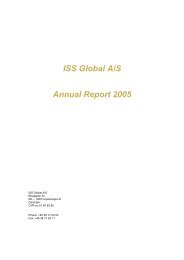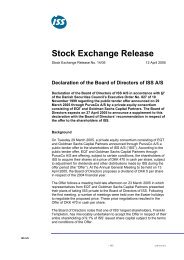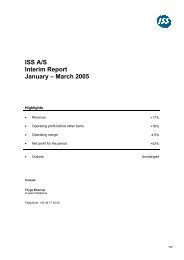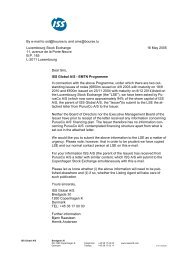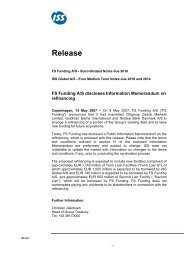I. Table of Contents - ISS
I. Table of Contents - ISS
I. Table of Contents - ISS
You also want an ePaper? Increase the reach of your titles
YUMPU automatically turns print PDFs into web optimized ePapers that Google loves.
tatiana\Bank Book\Public Bank Book\FINAL <strong>ISS</strong> PUBLIC Bank IM - Press Release to EMTN_1.doc 9 Nov 2005 10:32 41/91<br />
C. Demand Drivers<br />
<strong>ISS</strong> believes that the key drivers <strong>of</strong> the demand for facility services are, amongst others:<br />
41<br />
Industry Overview<br />
� Macroeconomics. Within a particular country, the demand for facility services generally correlates<br />
with economic conditions, including growth in that country’s gross domestic product. However, the<br />
facility services industry is normally considered to be less sensitive to economic cycles than certain<br />
other industries as there is a basic demand among customers for cleaning and other facility<br />
services in order to maintain their facilities and operate their businesses. In addition to being<br />
resilient in economic downturns, economic trends tend to affect facility services providers later in a<br />
macroeconomic cycle.<br />
� Outsourcing. There is a general trend toward outsourcing <strong>of</strong> facility service functions, which has in<br />
the past been a driver <strong>of</strong> demand for these services. The decision to outsource is dependent upon<br />
customer perceptions regarding the price and quality <strong>of</strong> outsourced services. Focused facility<br />
services companies seek to improve service quality and reduce customer costs by creating skill,<br />
scale and scope benefits across the various services delivered. Within the public sector, the<br />
decision to outsource is also based on price and quality considerations. However, decision making<br />
in the public sector is additionally influenced by political considerations, which will vary from country<br />
to country.<br />
D. Industry Characteristics<br />
Fragmented industry. The market among small and medium sized customers for basic facility<br />
services is highly fragmented, and there are believed to be more than 75,000 operators in this market.<br />
The independent market survey concluded that about two-thirds <strong>of</strong> these operators employ fewer than<br />
ten people. Basic facility services, including general cleaning services, can be provided with very<br />
limited resources and, as a result <strong>of</strong> these low barriers to entry, it is likely that the market for basic<br />
facility services will continue to include a large number <strong>of</strong> smaller operators. However, within each<br />
market there are generally only a few providers that have sufficient resources to provide customers<br />
with a full-range <strong>of</strong> facility services and to service larger, multi-location customers.<br />
E. Industry Trends<br />
� Pr<strong>of</strong>essionalisation <strong>of</strong> the facility services industry. Facility services have historically been<br />
delivered on a local basis and, due to the fragmented nature <strong>of</strong> the market, users have in the past<br />
tended to view these services as a commoditized service. However, as part <strong>of</strong> the industry<br />
consolidation and emergence <strong>of</strong> integrated facility services, facility services providers like <strong>ISS</strong> are<br />
increasingly able to differentiate their services and leverage their scope and scale to establish<br />
reputations and brand identities. As a result, there is an increasing division between the larger<br />
facility services companies with integrated facility services capabilities and providers <strong>of</strong> basic<br />
services to smaller customers.<br />
� Industry consolidation. The facility services market is undergoing consolidation as larger facility<br />
services providers seek to achieve economic benefits associated with the creation <strong>of</strong> operational<br />
scale and scope at the local, national and international level. Local benefits include the crossutilization<br />
<strong>of</strong> resources between sites, leveraging <strong>of</strong> overhead costs and sharing <strong>of</strong> best practices.<br />
At the national level, benefits accrue mainly in the form <strong>of</strong> increased credibility as a contract<br />
provider and more efficient management and administrative functions. At the international level,<br />
the service provider is able to leverage existing customer relationships across regions to gain<br />
further contracts, purchasing benefits and further share best practices and management<br />
capabilities.<br />
� Service integration. <strong>ISS</strong> believes that there is increasing demand for integrated facility services,<br />
which the independent market survey defines as the provision <strong>of</strong> multiple facility services managed<br />
on-site by the provider through a single point <strong>of</strong> contact. The independent market survey<br />
concluded that the market for integrated facility services had revenue growth <strong>of</strong> approximately 12%<br />
from 2000 to 2003. As integrated facility services is a relatively new trend, its penetration rate<br />
remains low and projected revenue growth rates are higher than the growth rate <strong>of</strong> the general<br />
facility services market.



